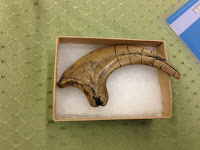I'm a big fan of Mr. McGroovy's box rivets, they let you make all different sizes of cardboard creations without needing all giant appliance boxes. I think the biggest of any of the boxes below was 2ft x 4ft. The rivets are reusable, though I'd say about 60% of the ones I try to pull apart do so without breaking. Still, a single $20 box of them has gotten us through 4 different builds. I use a sharpish phillips-head screwdriver to make the holes in the boxes for the rivets. I find it makes the most secure structures if you use multiple layers of cardboard. The first build with our set was a gingerbread house that my supervisor made. Next I created a Magic Tree House for a program to mark the author's birthday. I wanted to get some height so I stacked up a number of pallets I found in the basement, including a handy plywood platform that made it so kids wouldn't fall through the slats. That ended up being played in and loved for about three months. The tree was something a coworker had made as a thankful tree for thanksgiving. During my program the kids made "boards" and leaves to decorate it.
At some point the roof caved in and I took it off, I was suddenly deluged with dozens of concerned kids begging me not to take it down. Instead we decided to just keep going and I made this pirate ship. I know, it looks a bit like a tugboat, but the flag and figurehead made by our ace artist library assistant help sell it. This was also very popular but the pallets it's on were incredibly noisy, since we only had one platform and the pallets were more spread out there was a combination of individual planking and cardboard flooring to make it safer. I added some heavy duty cardboard tubes leftover from Muggle Quidditch to give the top some extra support and there's a box acting a little like a chimney in the back to further support the roof. Having something to go inside was clearly very important to them with the tree house so I needed to maintain that.
Once the pirate ship started getting worn out my coworker requested a fire truck. We decided to scale down with it and go to just one pallet. We uncovered some old foamcore displays and used a few pieces to make flooring. Since the firetruck is smaller only small children can stand on that part and falling through the pallet slats is alleviated by the foamcore. The pièce de résistance was an old plastic tray from some long ago platter that I cut a hole in the middle of and used a rivet to attach it a small box to act as a real spinning steering wheel for the firetruck. We ended up painting the firetruck red in a program and I have to say it really didn't help it. I've heard latex paint used for interior walls is really the best to use on cardboard. We used tempera and it just ended up very transparent and kind of rusty looking. It also dampened the cardboard a lot, cutting down on the clean lines. I moved on from this position before creating another structure, I hope someone else picked up the torch because the kids really loved playing in them.

















